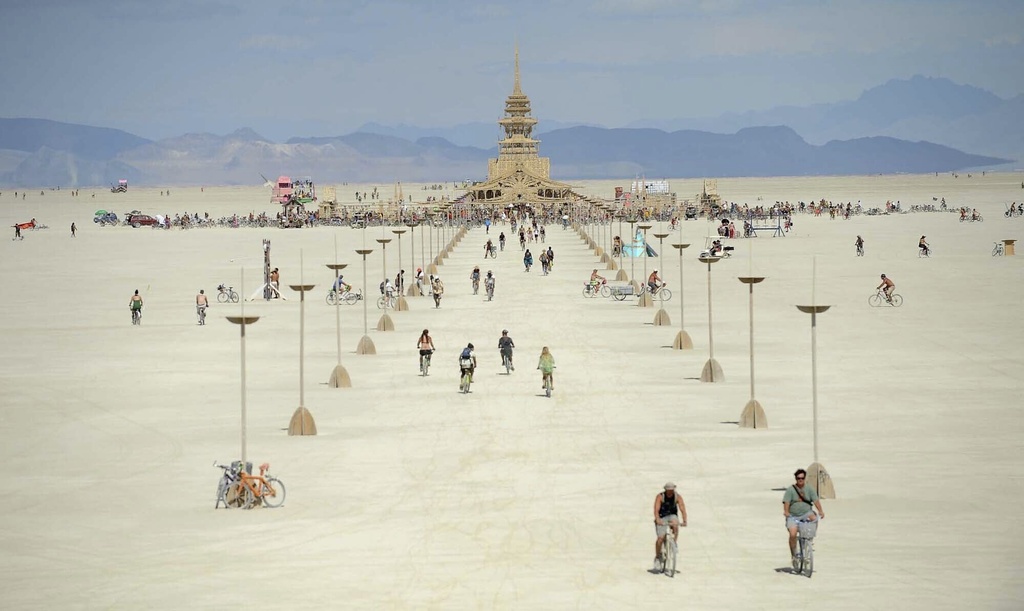Burning Man, the annual desert bacchanal that last year became a mud-soaked quagmire, has released a last-minute pool of around 3,000 tickets in response to sagging sales. Attendance has faltered post-pandemic due to extreme weather events, from heatwaves to flooding, which last Labor Day Weekend sent many burners, including comedian Chris Rock and DJ Diplo, fleeing from the Nevada desert.
While it’s not unusual for a pool of tickets to be released in the weeks before festivities, the festival’s organizers have usually required those who want last-minute tickets to pre-register earlier in the year. Organizers have also reopened their ticket aid program, giving people access to lower-priced $220 tickets, to encourage newcomers and returning burners who were turned off by their experience last year.
“We are pleased to have fulfilled demand for our earlier sales and be in a position to offer greater access to more people as the event nears,” Marian Goodell, CEO of Burning Man, said in a press release. “This ticket sale is an exciting opportunity to connect more people interested in Burning Man and the arts and culture.”
However, veteran burners say, this exciting opportunity has also come with more headaches and hardships in recent years.
For the past 20 years, Alameda resident Marisa Lenhardt has led the Death Guild Thunderdome camp, one of the better-known desert camps specializing in concocting gothic (but friendly) cage fights. She said that it was “incredibly unusual” for the festival not to sell out by this point, and attributed this year’s low attendance to extreme weather events over the last two years and soaring ticket prices, which are at least $780 for entry to the festival with a vehicle.
“There are huge climate changes and finances are fuckin’ real,” Lenhardt said by phone. “Several people have told me they won’t come back without something air-conditioned.”
With celebrity sightings, private parties and an enormous glut of fuel and resources required to make the whole festival happen, the state of Burning Man today is a far cry from its beginnings on Baker Beach in the mid-80s, when a group of 35 attendees burned an eight-foot-tall effigy as a pagan tribute. The effigy, along with the crowd, slowly grew until 1990 when 500 proto-burners flocked to Black Rock Desert for what people would later compare to the beginning of the internet.
By 2011, the event was so popular that it sold out for the first time within a day of ticket releases, turning an event based on radical inclusivity into something that only a lucky 53,000 could attend. Less than a decade later, attendance rose to nearly 79,000.
Like most global events, the festival was put on a hiatus in 2020 due to the pandemic. Still, that didn’t stop about 5,000 Burners from congregating in the Nevada desert and around 1,000 from descending on Ocean Beach in San Francisco for an extemporaneous shindig—the latter of which was lambasted as irresponsible by Mayor London Breed.
In 2022, temperatures reached 103 on the alkali floor of the playa during the reborn festival—the highest in recorded history for the area, according to the National Oceanic and Atmospheric Association—leaving some attendees addled with heat stroke.
Last year, the festival experienced its most epic debacle when record rains ravaged camps across Black Rock City and left around 77,000 attendees temporarily marooned along the swirling concourse of rock and clay.
Veteran attendee Ryan Considine told The Standard that his San Francisco-based camp, Ideate, would not be returning to the playa this year, citing burnout and costs.
“I did a shit ton of work last year, [and] I feel like we had a great camp,” said Considine. “But it’s a very expensive run.”
